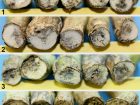
Features
Agronomy
Diseases
Blackleg control strategies
Blackleg disease is on the rise. Research scientist Gary Peng, with Agriculture and Agri-Food Canada (AAFC) in Saskatoon, says tighter canola rotations have meant an increase in virulent races of the blackleg pathogen.
July 24, 2018 By Bruce Barker
However, properly identifying the disease through scouting will help canola producers assess their risk of blackleg on each field to help guide them when selecting blackleg-resistant hybrids.
Scout for the disease
“Producers need to first scout their crops for the disease and know how to identify it. If they are able to find significant levels of the disease they then need to make sure they are growing a R/MR variety and look at extending their crop rotation,” says Justine Cornelsen, Western Manitoba agronomy specialist with the Canola Council of Canada (CCC) at Onanole, Man.
The best time to survey a crop for yield loss from blackleg is just prior to swathing or straight cutting. Pull up at least 50 plants in a “w-pattern” starting at field’s edge. Cut the base of the stem/top of root and look for blackened tissue inside the crown of the stem.
Peng developed a pictorial guide to help farmers assess the level of disease. His Blackleg Field Rating Scale runs from zero to five and helps provide an indication of the severity of the disease.
“If you don’t have major blackleg damage, there’s no urgency for you to switch between resistance groups right away,” Peng says.
Assess your risk
The Blackleg Steering Group (BSG), chaired by the CCC, has been working to help producers reduce the impact of blackleg. Previously a risk assessment matrix was used. The matrix is being discontinued and a simplified, step-by-step procedure is being developed for managing the disease.
Cornelsen says the main recommendations are a continued emphasis on crop scouting and lengthening the crop rotation for managing blackleg. Rotation of different R-gene groups needs to occur when there are significant blackleg levels within a field.
“We recommend that producers monitor crops yearly to determine if blackleg levels are changing. If blackleg is not an issue, there is no need to rotate your variety to a different group,” Cornelsen says.
Peng cautions that resistant-gene rotation isn’t a silver bullet. “In reality over 90 races have been detected. That means with every known resistance gene, there is at least one virulent isolate out there that would be able to overcome the resistance right away,” he says. “Therefore, other management practices, including crop rotation and disease scouting, should be diligently conducted. Many of our varieties have shown a level of background resistance against blackleg, which is of great value to blackleg management on the Prairies for most of the years.”
